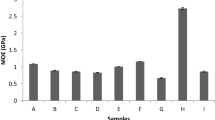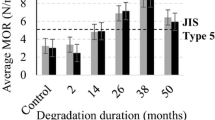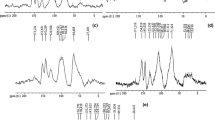Abstract
The feasibility of manufacturing phosphate bonded wood composite board products from four locally occurring invasive acacia tree species (Acacia cyclops, A. saligna, A. mearnsii and A. longifolia) was studied using a formulated magnesium oxide (MgO) and monopotassium phosphate (KH2PO4) binder system. The optimization for the manufacturing process was studied using a central composite statistical design, whereupon the following factors were considered, i.e. KH2PO4: MgO ratio, the fly ash content as partial replacement for the binder and the wood content as a ratio of wood to the total inorganic content. A fitted response surface plot was used to show the effect of the main factors and their interactions on the measured board properties. A response surface model was developed to predict the parameters leading to the best board properties. All physical properties evaluated met or exceeded the minimum requirements for low density particleboards. The results showed that the variables considered have significant effects on the physical properties of the boards. The optimum composite manufacturing process for making durable products within the scope of the studied species was found to be a KH2PO4/MgO ratio of 1.66, an ash content of 2.7% and a wood/inorganic ratio of 0.96 for the selected wood species.








Similar content being viewed by others
References
Amiandamhen SO, Meincken M, Tyhoda L (2016) Magnesium based phosphate cement binder for composite panels: a response surface methodology for optimisation of processing variables in boards produced from agricultural and wood processing industrial residues. Ind Crops Prod 94:746–754
ASTM (1999) Standard test methods for evaluating properties of wood-base fibre and particle panel materials, D1037-99. ASTM International, West Conshohocken. http://www.astm.org
Bloor S, England RR (1991) Elucidation and optimization of the medium constituents controlling antibiotic production by Cyanobacterium Nostoc muscorum. Enzyme Microb Technol 13:76–80
Cantwell WJ. Morton J (1991) The impact resistance of composite materials: a review. Composites 22(5):347–362
Chi H, Englund KR (2014) Interfacial properties of magnesium phosphate ceramics and sugar maple (Acer saccharum). Holzforschung 68(5):575–582
Colorado HA, Hiel C, Hahn T, Yang JM (2011) Wollastonite-based chemically bonded phosphate ceramic composites. In: Cuppoletti DJ (ed) Metal, ceramic and polymeric composites for various uses, vol 13. INTECH Open Science, Shanghai, pp 265–282.
Donahue PK, Aro MD (2010) Durable phosphate-bonded natural fiber composites products. Constr Build Mater 24(2010):215–219
Formosa J, Lacasta AM, Navarro A, del Valle-Zermeno R, Niubo M, Rosell JR, Chimenos JM (2015) Magnesium phosphate cements formulated with a low-grade MgO by-product: physico-mechanical and durability aspects. Constr Build Mater 91:150–157
Gonzalez A, Foster KL, Hanrahan G (2007) Method development and validation for optimized separation of benzol[a]pyrene-quinone isomers using liquid chromatography–mass spectrometry and chemometric response surface methodology. J Chromatogr A 1167(2):135–142
Gorgens AHM, Wilgen BW (2004) Invasive alien plants and water resources: an assessment of current understanding, predictive ability and research challenges. S Afr J Sci 100:27–33
Ibrahim WA, Sibak HA, Abadir MF (2011) Preparation and characterization of chemically bonded phosphate ceramics (CBPC) for encapsulation of harmful waste. J Am Sci 7(9):543–548
Irle M, Barbu MC, Reh R, Bergland L, Rowell RM (2013) Wood composites. In: Rowell RM (ed) Handbook of wood chemistry and wood composites, 2nd edn. CRC Press, Boca Raton, pp 321–411
Jeong SY, Wagh AS (2002) Chemical bonding phosphate ceramics: cementing the gap between ceramics, cements, and polymers, Argonne National Laboratory report. Contract No. W-31-109-ENG-38 under US Department of Energy. Lemont, IL USA. University of Chicago
Laufenberg TL, Aro M (2004) Phosphate bonded ceramic wood composites. In: Proc. ninth international conference on inorganic bonded composite materials, Vancouver, pp 84–91
Macdonald IAW (1986) Invasive alien plants and their control in Southern African nature reserves. In: Proc. conference on science in the National Parks. Colorado State University, Fort Collins, pp 63–79
Maran JP, Manikandan S (2012) Response surface modelling and optimization of process parameters for aqueous extraction of pigments from prickly pear (Opuntia ficus-indica) fruit. Dyes Pigm 95:465–472
Mohr BJ, El-Ashkar NH, Kurtis KE (2004) Fibre cement composites for housing construction: state of the art review. NSF Housing Research Agenda Workshop, Orlando, pp 112–128
Richardson DM, Wilgen BW (2004) Invasive alien plants in South Africa: how well do we understand the ecological impacts? S Afr J Sci 100:45–52
Theron JM, Laar A, Kunneke A, Bredenkamp BV (2004) A preliminary assessment of utilizable biomass in invading Acacia stands on the Cape coastal plains. S Afr J Sci 100:123–125
Wagh AS (2004) Chemically bonded phosphate ceramics. Elsevier, Amsterdam
Wagh AS (2013) Recent progress in chemically bonded phosphate ceramics. ISRN Ceram. doi:10.1155/2013/983731
Youngquist JA (1999) Wood handbook: Wood as an engineering material. Chap. 10. Wood based composites and panel products. Gen Tech Rep FPL–GTR–113. USDA, Forest Service, Madison
Zhao J, Wang X, Chang J, Zheng K (2008) Optimization of processing variables in wood–rubber composite panel manufacturing technology. Bioresour Technol 99:2384–2391
Acknowledgements
The authors thank the National Research Foundation (NRF) for financial support (Grant Number 88598). We also acknowledge EC biomass, PE and Ulula fly ash, Kriel, South Africa for material donation.
Author information
Authors and Affiliations
Corresponding author
Rights and permissions
About this article
Cite this article
Amiandamhen, S.O., Montecuccoli, Z., Meincken, M. et al. Phosphate bonded wood composite products from invasive Acacia trees occurring on the Cape Coastal plains of South Africa. Eur. J. Wood Prod. 76, 437–444 (2018). https://doi.org/10.1007/s00107-017-1191-x
Received:
Published:
Issue Date:
DOI: https://doi.org/10.1007/s00107-017-1191-x




